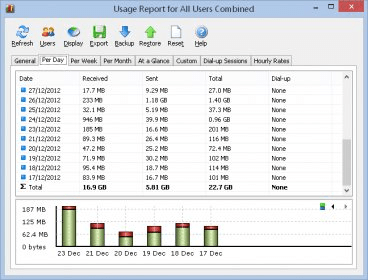

It doesn’t sound like much, but these drop-outs are spread out over a few seconds here and there, and it is irritating. According to the built-in statistics page, gaps in the satellite coverage has resulted in five minutes of downtime over the last 24 hours, with an additional two minutes of miscellaneous downtime: two nines. That’s not to say that there aren’t any problems. Ping times are low enough that latency isn’t a noticeable problem. It’s not Gigabit fiber, but I’m regularly getting 200 Mbps down and 15 Mbps up. The system may eventually be robust enough to work well with obstructions, but for now, obstructions still means service interruptions, so setting the dish in the open is critical. Some optimizations have been added recently to be more fault tolerant of obstructions, like an automated fail-over to a secondary satellite when the preferred endpoint is unavailable. Because the system talks to satellites that are continually moving, the window of sky that needs to be clear is quite wide. Tree leaves are enough to completely block the signal. Dishy needs a clear view of the sky, and the EHF frequency in use is very sensitive to physical barriers. The biggest issue to wrestle with is avoiding obstructions. From there, the phased array antenna steers the beam to precisely target the overflying satellites. Dishy determines its location and orientation on boot, and automatically points itself in the proper direction.
#HUGHESNET USAGE METER FOR MAC MANUAL#
There’s none of the fiddly manual pointing that other dishes require. The dish itself is motorized and automatic. I’ve not yet found any other PoE implementations that push that much power, so it seems that we’re limited to using the supplied power supply for Dishy. For those following along at home, that’s just under 180 watts of power down a Cat5e cable. One supplies the router low power, but the other port supplies the satellite dish with 56 V at 1.6 A x 2.
#HUGHESNET USAGE METER FOR MAC SERIAL#
Once you’ve made it in, however, there is a header that is likely a serial port. Taking the case apart was quite a pain, as the seams are tight, and the clips are recessed a bit. Of great interest to me, however, is the fact that the router reports itself to be an OpenWRT device.

The router itself is uninteresting, and has an initial setup page to configure the WiFi, and no further configurations. In the box, you get a router, a PoE injector, a simple tripod, and “Dishy McFlatface” - the innovative satellite dish with a permanently attached 100-ft Ethernet cable. Here’s my experience, and a bonus hack to boot. I got a Starlink setup, and have been trying out the beta service. Since the speed of light is higher in a vacuum than in a fiber-optic cable, the fully deployed system could potentially have lower latency than even fiber Internet, depending on the location of the endpoint and how many hops need to be made.

The long-term plan is to allow the satellites to talk directly to each other over laser links, skipping over the ground stations. The way Starlink works right now, data goes up to the closest satellite and directly back to the connected ground station. In the few weeks I’ve had the service, ping times have fallen from mid-60s down to 20s and 30s. Starlink predicts a theoretical minimum of under 10 ms, though real-world performance isn’t quite that low yet. A Hughesnet connection has a minimum theoretical latency of 480 ms, and in reality runs closer to 600 ms. This hundred-fold difference in altitude matters. So far, nearly 1,600 Starlink satellites are in orbit, in a criss-crossing pattern at 342 miles (550 km) up. The downside of flying so low is that they won’t stay in orbit as long, but SpaceX is launching them significantly faster than they’re coming down. In what seemed like an insane pipe dream at the time, they planned to launch a satellite constellation of 12,000 birds, some of them flying as low as 214 mile altitude. SpaceX opted to do something a bit different. To quote Grace Hopper, holding a nearly foot-long length of wire representing a nanosecond, “Between here and the satellite, there are a very large number nanoseconds.” Hughesnet, another provider, has a handful of satellites in geostationary orbit, which is about 22,000 miles above the earth. And while satellite Internet isn’t exactly new, Starlink is a bit different. Wireless and cellular internet have helped in some places, but if you really live out in the sticks, satellite internet is your only option. Starlink is SpaceX’s satellite Internet service. Having excess launch capacity means that space projects that were previously infeasible become suddenly at least plausible. But the side-effect of SpaceX’s reusable launch system is that getting to space has become a lot cheaper.

I catch their launches when I can, and I’ve watched the development of Starship with great interest. I could probably be described as a SpaceX enthusiast.


 0 kommentar(er)
0 kommentar(er)
